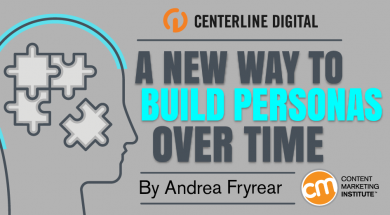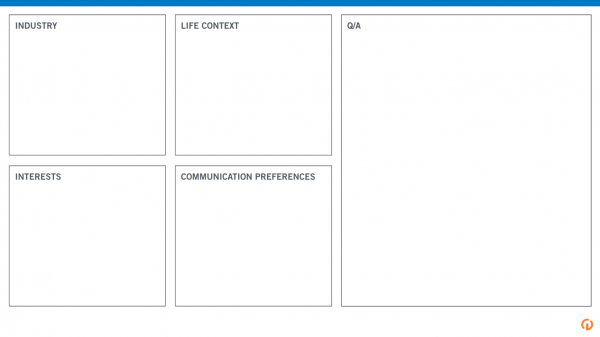SPONSORED BY CENTERLINE
Centerline’s chief strategy officer John Lane is on a mission to change the way that we think about our personas. Instead of investing a disproportionate amount of time up front creating a perfect persona that you never revise, he recommends adopting an iterative approach.
I asked him more about how this approach works and why he think it’s a crucial shift for content marketers.
Let’s start with the basics. What does iteration mean in a general sense?
Traditional project planning focuses on getting as much information up front as possible and then using it to create a major project that typically takes a long time to complete. Once the project is finished, it’s finished forever. There’s rarely a plan to revisit and improve it in the future, because planning and execution are so labor-intensive.
An iterative approach, on the other hand, prefers to start with the smallest amount of information needed to create something, make it, and see what happens. Based on the incoming data and audience response, the next version, or iteration, is produced and released. This process repeats, steadily improving the project over time.
Both approaches get you a finished product, but one takes far less time, involves direct communication with the audience for the content, and allows for regular adjustments to both the product and plan.
So what makes a persona iterative?
An iterative persona is one that is specifically created to change over time, rather than one that’s designed to stay the same. It’s created with open-ended questions rather than definitive answers.
What attracted you to the idea of iterative personas in the first place?
Well, I’ve been at Centerline for nearly 13 years so I’ve seen a LOT of personas, and various systems for creating them. Some clients had really big binders of hundreds of different types of personas, trying to get down to a highly specific level of understanding for each sub-group. Others had personas that were three or four years old, and they had never been updated.
It started becoming clear that we needed to come up with a better way to understand personas from a human rather than a demographic perspective. We needed to do it in a way that was current, so people didn’t feel like their personas were too precious or that they couldn’t touch them. And we also had to make sure the personas weren’t so highly specific that they blocked you from having creative freedom to reach the people you were trying to communicate with.
After talking to clients we realized the root of the problem was the process of building personas. People were taking so much time to build them, they became things to be revered rather than used. We stripped that process down to make it something that could happen rapidly and be added to over time.
What’s the biggest win when adopting iterative personas?
The primary benefit for our clients has been that these types of personas are freeing. When you have lots of highly prescriptive personas, ones that have gotten down to a really fine level of detail, then people freeze up and don’t know how to communicate with people differently based on these minute changes.
But this is a mindset shift too; it’s a trained thing. It’s not immediately freeing just because you changed the way you do the persona. It’s freeing when you accept the process of change, of having a persona that you feel comfortable changing and questioning.
What’s the best type of situation for using this approach?
Iterative personas work the best when there’s some additional complexity in the buying process.
For example when it comes to B2B buying, there’s an awful lot of complexity. There are multiple stakeholders in the buying process, a lot of different aspects that you have to take into account. That includes the fact that it might not be one department’s budget, it might not be only one division that gets to purchase something and use it. So there could be many different points of view that are involved in the purchase.
But you still see that level of complexity in some B2C buying too. If you think about someone buying a minivan, there are multiple stakeholders in that process. There’s not just the driver, there are the people being toted around, there are different uses for different people within a family. It becomes a much more complex buy because there are a lot more use cases.
So the iterative personas are very useful in these complex situations. They don’t nail you down to one stakeholder, they open your mind to think of multiple stakeholders and where the overlaps in those stakeholder perceptions are.
How would I go about doing this on my team? Walk me through some of the first steps.
I recommend that you start with a particular exercise that frees up the way you think about your audience. You ask people to go out and come back with three or four artifacts related to the audience as they see it now. They don’t have to be things that are related to your product, or even to the value that the audience is seeking from your product. These should just be things that represent the audience.
Even if you do this with a small team, you’ll end up with a lot of different things. And it sparks debate from a human level, making you think about where different people overlap and have things in common. It can also show you distinctions and make you think about what they mean for the kinds of content you should create or the channels you should use to reach them.
When we do this with our clients, we bring in things based on what they’ve told us about their audience. For example, we might bring in these four objects:
Then we use a worksheet like the one below, asking participants to think about the industry the person works in, what kind of information matters to them, what type of communication they seem to prefer, and what that means to them as a content team or brand.
(Note: A large percentage of this worksheet is devoted to Q&A for a reason. This is where we write down the questions these objects bring up, and then try to come up with content ideas that would help you answer those questions.)
What’s great about this exercise is that almost every person or group will come up with a different portrait of the audience member who owns these objects.
Do they belong to an older empty nester with plenty of resources to travel, who’s now spending their time and money going to Broadway plays? Or is their owner younger, maybe a single, recent college graduate with disposable income who lives in a small Manhattan apartment to be close to culture?
It could be either one, and maybe both types of people fall into the audience for your content.
The lesson here is that through the discussion that this exercise produces, you start to see your audience as a collection of individuals, rather than just an aggregated, static image.
And you’re also coming up with commonalities among the differing descriptions that can lead to truly engaging, audience-centered content, regardless of traditional demographics.
Once a team discusses these artifacts, what happens next?
The next step might be to push it to the next level by asking, “What questions and answers does all of this bring up? What content and channels can we use to answer those questions?” Your goal is to expand on this persona with knowledge, and you’ve got to put content out in front of the audience to get that knowledge.
Then you want to see how the audience uses and responds to your content. How is it shared? What’s the language around how it gets shared? Monitoring those things and adjusting your persona accordingly, that’s an active part of building a persona over time.
Rather than infer it or try to assume what people might do, releasing content allows you to immediately come back to that persona and say, “What did we learn? How can we revise it? How can we get more specific? What new questions does this bring up?”
And the next steps can absolutely include things like A/B testing and channel testing with small bets. For example, you could do a promoted tweet and a sponsored LinkedIn post with the same type of content and see which one actually performs better. You also want to monitor what you saw around those posts in terms of action and sharing and sentiment.
How do I really iterate on my persona?
After you put something out you’ve got to come back and look at the persona with a critical eye. Expand it, change it, find some new questions and then do it all again.
If you stop after the first one, you’ve only answered a portion of the question.
Conclusion
By starting with a much less time-intensive version of persona creation at the outset, you can get more relevant content into the market much more quickly. And you can use all the time that you save for moments of examination and adaptation in the future.
You can iterate continually over time, always adding more value for the audience as you learn more about them.
For more detail on iterative personas and the Agile marketing framework that supports them, download this free ebook from Centerline.
The post New Way to Build Personas Over Time appeared first on Content Marketing Institute.



No comments:
Post a Comment